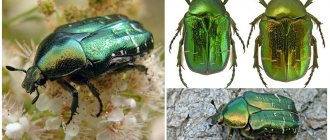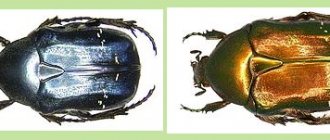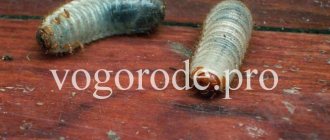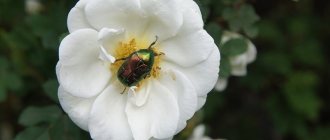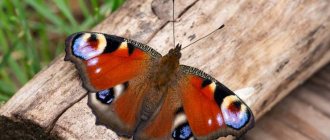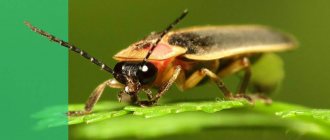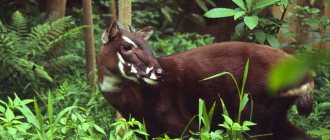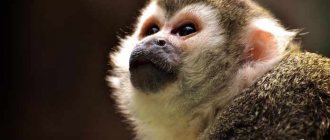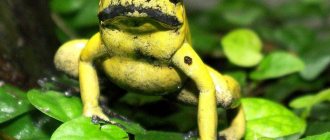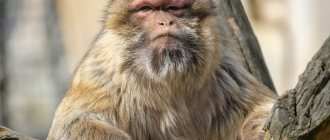Habitats and biology
Habitats are old broad-leaved and coniferous-deciduous forests with the participation of old oaks, the main or only food plant of the larvae [1]. Indications of development in some fruit trees [4-6] in the region have not been confirmed. The larva develops in the rotting cavity of old hollow-leaved deciduous trees, where it overwinters and pupates [6]. The beetles were recorded in June-July (possibly sometimes hatching at the end of summer and overwintering); active during the day, staying along heated forest edges and clearings, found in hollows and on tree trunks [1-3, 5]; According to the literature, they feed on flowing tree sap, less often on ripe fruits of pears and apple trees, as well as on the flowers of shrubs [6].
Offspring
Smooth bronze beetles lay their eggs in wood dust. The hatched larva begins to actively replenish nutrients by eating wood. The larva can reach up to 6 centimeters in length. The limbs of the larvae do not have hooks, so at the moment of danger it turns over on its back. The elytra of the larva are formed with the onset of the pupal phase. The smooth bronze cocoon has two layers:
- an outer layer with many small tubercles formed from wood dust;
- an even and smooth inner layer formed by the secretions of the larva itself.
At the pupal stage, the almost formed adult bronze beetle remains in the cocoon until the shell hardens. Due to the internal texture, the elytra of the smooth bronzer get the desired shape. Most individuals are formed from August to September. These beetles reproduce every three years.
Limiting factors and threats
Moderately stenotopic, but narrowly local and small in number, the species does not realize the apparently favorable opportunities for increasing its numbers, even if there is a potential food supply in the forests of the region. These factors suggest increased isolation of populations from the southern Tula abatis and almost complete isolation from most other areas. The decline in the number of the species is caused, first of all, by cutting down and death of old hollow oaks, suitable for the development of larvae, and, to a lesser extent, by fires and, possibly, anthropogenic pollution. In the long term, the slow self-renewal of oak is also unfavorable.
Lifestyle
Bronze cats lead an active lifestyle during daylight hours, especially loving sunny, bright days. Then they fly from place to place, moving at an impressive speed for such massive insects. It happens that a bronze bird does not have time to go around an obstacle it encounters, crashes into it and falls to the ground with a dull thud.
A bronze whale that falls from the sky usually lands on its back and flounders in the dust for a long time before it manages to regain its former balance. But in most cases, bronzes are very maneuverable, and rarely lose face. The beetle spends energy sparingly; it tries to choose flowers and inflorescences on which it can linger longer in order to both rest and eat.
In cloudy weather, they try not to get out of their shelters, which are provided by the leaves and roots of plants. Overnight stays are also most often arranged on the ground. The bronzes spend the winter months there in the ground. In different areas of the range, the activity of bronzes varies. In some places the flight lasts 2.5 months, in others 4.5 months, depending on the number of hot days.
Security measures taken and required
In the Tula region. There is 1 protected area (PP "Skalnye... near the village of Venev-Monastyr") with the habitat of the species, another 1 of them may be located at the PP "Aleksinsky Bor". It is necessary to limit economic activity in the habitats of the species through the creation of protected areas and public areas. It is necessary to create protected areas in the “Dacha Oka Forest” and “Dacha Upa Forest” massifs (Suvorovsky and Belevsky districts). Do not allow the killing of individuals; prohibit the cutting of old hollow oaks (or leaving their trunks to a height of 1.5-2 m) and the lighting of fires outside designated areas; limit cutting of remaining oak trees as much as possible; prohibit chemical treatments within a radius of at least 100 m from habitats; expand oak plantings. Investigate the possibility of introducing the species into suitable forest biogeocenoses.
Appearance
The smooth bronzer has an oval and convex body. A distinctive feature is the wing elytra, which do not rise. The hind wings open through special slits that are located on the side of the body. This structural feature allows bronzebacks to fly well. The head of these representatives is relatively small, very different from the width of the body and slightly tilted. Smooth bronzebacks have antennae that perform the function of searching for individuals for reproduction and food. The front legs are equipped with sharp spines, and the elytra are slightly compressed. The smooth bronzer is famous for its beautiful color, which has a bright green color with a characteristic metallic sheen. Some individuals may have a bluish-copper tint. The limbs are colored green with a blue tint.
Number and trends of its change
It is a very rare species in the region [1-3, 5, 7]. In the Tula region. 4 system-forming habitats are known in forests with areas ranging from several tens to hundreds of hectares, but coenopopulations and foci are located in individual extremely or very compact areas with groups of fodder trees; the state of all populations requires clarification. In each of them, mainly at the end of the twentieth century. from 1 to several beetles were noted, in one case also 11 larvae (10 beetles bred in the laboratory were released into the wild).
Methods of combating the bronze beetle
Are you afraid of bugs?
Not really
The bronze beetle is relatively harmful to agriculture, so no special methods have been developed to combat it directly.
You can attract a natural enemy - the Scolia wasp. Female wasps are immobilized while laying eggs. Wasp larvae feed on bronze beetle larvae.
One of the most common is the mechanical method. Early in the morning, beetles are collected from flowers by hand. Insects are placed in a jar with kerosene.
Chemicals
Chemicals are used in extreme cases. If the insect multiplies significantly, insecticides can be used carefully.
They use drugs that poison the Colorado potato beetle.
Spray the soil or introduce medications by watering. Treatment is carried out after sunset for the drug to start working. Apply:
- Decis;
- Spark;
- Lightning;
- Kinmiks.
Traditional methods
Among folk remedies, infusions with onions, horseradish, garlic, wormwood, tansy, and dandelion give good results. The following mixtures are particularly effective:
- horse celandine (300 g) is added to 1 liter of hot water. Leave for 2 days and spray, adding a teaspoon of grated soap;
- horse sorrel roots (30 g) are mixed with 1 liter of hot water and left for 4 hours. This solution is treated once every 5 days;
- wood ash is mixed with 5 liters of water and left for 48 hours. Add 1 tbsp. spoon of soap and spray.
Birch sapwood
A pest from the group of bark beetles. Settles on emaciated weakened trees, preferring birch trees. Widely distributed throughout Europe, in areas where favorite trees grow.
A small black beetle with shiny elytra. The male has long, thick hairs on his forehead, while the female has a bare forehead. The elytra are flat, dotted with dotted grooves. The antennae and paws are brown.
Various insecticidal agents are used to kill pests. Trees are treated with solutions of Fufanon, Karate-zeon, BI-58, and Zolon.
Golden bronze
- an esthete pest that eats probably the most beautiful garden flowers.
These golden-green beetles shimmer incredibly beautifully in the sun with a bronze-copper-gold tint. They captivate with their dazzling beauty, but in fact they are formidable pests. The beetles feed on flower parts, climb into the core of the buds and eat it away. After the core is destroyed, the bud simply does not open and withers.
Golden Bronzewort (Oxyturea fipesta Poda)
.
A large beetle from the lamellar beetle family (scarabaeidae). The body length is 14-20 mm, width - 12-14 mm, shiny green in color, and on the underside it has a bronze-golden color with a metallic sheen. On the lower part of the beetles' elytra there are thin light transverse lines in the form of strokes. Bronzebirds are characterized by a bright metallic sheen and grooves on the sides of their wing covers, which allows them to fly with their wings folded.
The larvae of the bronze beetle resemble the larvae of the cockchafer - white, thick, six-legged. Body length reaches 60 mm. They, like the larvae of the May beetle, feed on humus and plant debris in the soil without damaging the roots of cultivated plants. Golden bronze beetle is found in gardens from May to August. Beetles eat the flower petals of fruit trees. They can damage young shoots, leaves and fruits of apple and pear trees by gnawing deep holes in them. The golden bronze does not pose a great threat to orchards, and therefore no special protective measures have been developed against it. In gardens where treatments against other pests are carried out, golden bronze is rare.
Golden bronze grass causes great harm to flower and ornamental crops. She completely eats the flowers of roses, irises, phlox, poppies, peonies, viburnum, lilac, and hawthorn. It can damage young shoots on bushes, as well as young leaves, gnawing their edges. The generation of green bronze is one-year. Young beetles, born in the fall, overwinter in the soil.
Lifestyle Features
Insects of this species live in gardens, forests, orchards and parks. The main places where females lay eggs are manure or compost heaps or rotten stumps. Overwintering of larvae and adults also takes place here. Bronzovkas prefer deciduous trees - they are not interested in coniferous trees.
These beetles have natural enemies. Thus, typhus and scolius wasps and tachina flies parasitize their larvae. Adults very often run the risk of becoming prey to various birds. As for animals, they do not eat bronzes. And the toxin contained in the body of these beetles is destructive for small predators. Bronzers are especially active during the day, in sunny and dry weather.
Other ground insect pests
Most often, the roots of garden and berry crops suffer from underground pests, which eat various insects or their larvae living in the soil:
- centipedes - small individuals, breed in compost heaps, eat flower bulbs, strawberry fruits, strong population growth is observed at high humidity;
- earthworms and earthworms - although they are beneficial by digging up the top layer of soil, they have a negative effect on the adhesion of roots and soil, which can cause plants to be pulled underground;
- cutworm caterpillars (winter and exclamation) - in the spring months they live underground and feed on the roots of vegetable crops, preferring cabbage, carrots and seedlings of ornamental flowers, they also gnaw leaves and root vegetables;
- wireworm larvae (striped or bread nutcracker) - attack vegetable crops, strawberry and strawberry plantings, eating small roots and larger roots, damaging root crops and flower bulbs;
- May beetle larvae - live for several years in the soil, feeding on underground parts of plants (vegetables, shrubs and fruit trees);
- springtails - white jumping insects settle in the ground near garden and house plants.
Garden pests
Golden or common bronzeweed (Cetonia aurata)
A bit of officialdom.
The golden bronze beetle is a representative of
the order Coleoptera
or beetles
(Coleoptera)
,
the family of lamellar beetles (Scarabaeidae)
,
the genus Cetonia
(another Greek
“metal beetle”
).
Friends!
This is not just an advertisement, but my
personal request
. Please join the ZooBot group on VK. This is pleasant for me and useful for you: there will be a lot there that will not end up on the site in the form of articles.
aberrations
After reading the description of the appearance of the bronze on Wikipedia, I came across a bunch of interesting words, such as clypeus, pronotum and pygidium
. The description there takes up about a screen page and evokes approximately the same thoughts as the description of complex smells - all the words seem to be familiar, but still nothing is clear. So, I'll keep it short. Here she is:
Nutrition.
Bronzovka is an extremely peaceful and herbivorous creature. Loves flowers (including flowers of cultivated plants). However, in most cases, it does not pose any harm to agriculture. In addition to flowers, it eats young leaves of some plants, fruits, and tree sap. Large clusters of beetles can form where the sap comes out.
Recently, for the first time in my life, I caught a bronze bird not in flight, but eating.
The picture is quite funny. Somehow her actions reminded me of a cross between a trimmer and a harvester from the Dune II toy: Sexual Dimorphism
in the golden bronzer it is weakly expressed. The male is larger than the female.
Reproduction.
The female lays eggs in rotten stumps, dung heaps or anthills. The larva can reach an impressive size of 4-5 cm. It looks something like this:
In the photo it is unlikely that it is a bronze beetle larva, but the beetle larvae are more or less similar to each other, unlike.
The larva builds itself a cocoon from scrap materials, holding them together with a sticky secretion. Inside the cocoon, the transformation occurs into a pupa, and then into an adult beetle. The development cycle from egg to adult insect takes 2-3 years.
It is possible to keep the bronze beetle in captivity, and not only the adult beetles and their behavior are of interest to the observer, but also the larvae. Considering that all our species of insects are configured to wait out the winter and enter diapause, the southern species of bronzefish, in which life is in full swing all year round, are better suited as a pet.
PS:
Today I discovered that some people don’t know who the bronzeback is and call it.
So, what is shown in the photo is this !
It looks completely different, although it also belongs to the
lamellar family.
This insect, widespread in Europe, is often mistaken for the May beetle. It is difficult to say what caused this misconception. Golden bronze and Khrushchev (which belong to the same family, have a similar structure and lead approximately the same way of life, however, it is quite easy to distinguish one insect from another. Khrushchev look more “modest”, since they do not have the bright metallic sheen characteristic of bronze insects The color of their elytra is brown or reddish-brown, with whitish speckles. The chafer beetle is larger than the bronze beetle, its length reaches 3 cm. In addition, its body is more elongated and abundantly covered with hairs (except for the elytra). Unlike the bronze beetle, the chafer beetle recognized as an agricultural pest.
Genus Goliathus
Or goliath beetles. The largest representatives of the bronze subfamily. The weight of the beetle can reach 100 g, and the body size is 11.6 cm.
Large green beetles of the species Mecynorrhina torquata are not much smaller in size than Goliathus regius. The length of the male can reach 8.5 cm.
The main color of the representatives of the genus is black with white spots. Sometimes there is more white in color than black.
Goliaths are inhabitants of Central and Southeast Africa. They are not found in Russia. If such a beetle is found on Russian territory, it means that it escaped from someone’s terrarium.
Bronzovka beetle
many faces. It is a genus of insects, not a separate species. All bronze beetles are lamellar, that is, they are relatives of cockchafers and belong to the order Coleoptera. The scientific name of the beetle is cetonia. The word is Latin. Translation: “metal beetle.”
